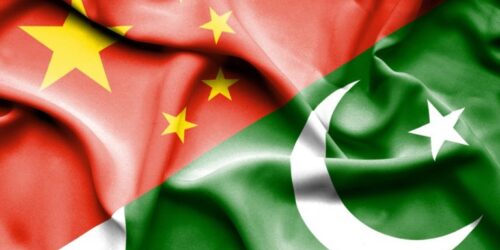Pakistan has asked China to direct its Export & Credit Insurance Corporation Sinosure to resolve the pending issues pertaining to ML-I and six energy projects.
“We have written two separate letters to National Development and Reform Commission (NDRC) for resolution of issues hampering the financial close of six energy projects and the term sheet for ML-I project,” Khalid Mansoor Special Assistant to the Prime Minister on CPEC Affairs said while talking to selected group of journalists here on Tuesday.
He said that Chinese companies in power sector have an overdue amount of Rs250 billion and the Sinosure, which underwrites loans, is not underwriting further loans for energy projects. He said that a letter was written to NDRC where it was asked to direct the Sinosure to fulfil its commitment regarding the six energy projects which it had already committed.
Similarly on ML-I projects the NDRC was asked to resolve the pending issues related to the terms sheet. On ML-I project, he said that Pakistan had already submitted its own plan and now term sheet from lender is awaited. He said that earlier cost of the ML-I was $9.2 billion, however in the revised PC-I was rationalised to $6.8 billion. He said that the cost of $9.2 billion was estimated after the feasibility study. The Chinese are of the opinion that the cost is underestimated. He said currently the proposed funding plan is 50/50 of Chinese currency and dollar.
SAPM Khalid Mansoor says Chinese companies in power sector have an overdue amount of Rs250b
“We have also proposed to them to determine the cost of ML-I through open bidding among the Chinese companies. They are not backtracking from their commitment of funding ML-I and soon you will hear good news about the project,” he claimed.
Khalid Mansoor said that CPEC is the last chance to industrialise the country.
He said that the time of entrance to CPEC project was critical as the country was facing severe load-shedding of up to 18 hours, which had enormously dented the GDP growth and export sector. Hundreds of thousands of looms in Faisalabad had been closed down because of unavailability of power in the national grid. Besides, the country was totally relying on Furnace Oil, the expensive imported fuel, which had created the balance of Payment problem for the country.
At that time Pakistan had planned to increase its electricity generation of 17000MW mostly based on indigenous fuel particularly coal. You cannot have 100 percent renewable as Tharmal Power Plants are required to jack up the system whenever the renewable energy is facing reduction.
With this background Chinese were contacted and the motto was expensive electricity is better than no electricity. He said that energy projects worth $13 billion have been completed while the projects worth $12 billion are in the pipeline.
Talking about the pre-CPEC bottleneck, the SAPM said that an addition of 17,000MW of electricity envisaged under CPEC, 2,739km highway , 1,733km railways, 820km optical fibre and 70km mass transit. Similarly an investment of $53 billion was envisioned.
It was also envisioned to enhance eco-growth by 2% – contribute each component of GDP eg agri, manufacturing, science & technology , mines & minerals, industrialisation etc. It was also envisioned to promote exports & substitute imports through CPEC SEZs, socio-economic development & poverty alleviation and enhanced rural urban connectivity.
The salient features of the MOU signed in July 2013 were to promote bilateral and regional connectivity, regional economic integration and investment, trade & logistical cooperation.
The first phase of CPEC was early harvest & short-term projects (2015-2020). It was the period of market cultivation and to address major bottlenecks to economic & social development addressed to boost economic growth.
Second Phase was medium-term projects (2020-2025), which was period of expansion and development, balanced regional economic development, processing & manufacturing industries.
The third phase was long-term projects (2030) the period of maturity and the mechanism for sustainable economic growth.
Talking about the outcomes of CPEC energy projects, he said that new electricity generation capacity of 5,300MW was installed with the transmission lines of 880km. Energy projects of 3,500MW are under implementation while 4,144MW are at planning stage.
Talking about the outcomes of the CPEC infrastructure projects, Khalid Mansoor said that 1800km of new motorways/highways/urban mass transit was completed, 820km of optic fibre laid, international airport at Gwadar is in progress,
He said that major upcoming infrastructure projects are 1733km railways – Main Line-1 (ML-1) projects, and Karachi Comprehensive Coastal Development Zone.
Under CPEC Industrial Cooperation, he said that nine Special Economic Zones (SEZs) and a Free Zone at Gwadar, four SEZs and Gwadar Free Zone being developed on priority.
He said that local and international companies have shown strong interest in SEZs. The international companies include Century Steel (China), Alptak ltd (Germany), Strong Stich (UK), Akzo Nobel ltd (Netherlands), Zhenbang Agriculture (China)
He said that investment in SEZs open to investors from all over the world.
About the CPEC phase-II the advisor said that it aims to accelerate socio-economic development of Pakistan by bringing industrial, technological and agricultural revolution through Chinese investment and transfer of technology.
The new areas of Cooperation include science & technology, agriculture and information technology.
SAPM said that they are establishing world class facilitation centres for the prospective investors of CPEC.







